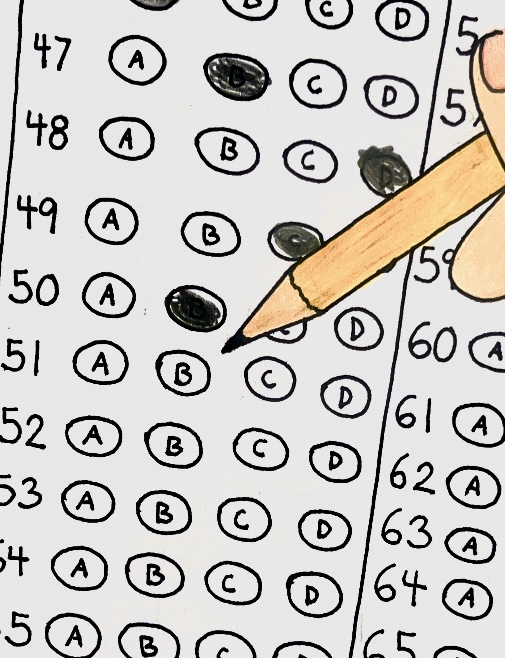Finicky keyboards, an unpredictable battery life and inefficient hall passes – all of these are among the new obstacles Pali students faced at the start of the 2023-24 school year.
Pali administrators implemented two new policies intended to keep students safe and on task. The 1:1 computer program requires students to use a school-issued device during class each day. The E-Hall pass system constitutes a teacher-approved electronic pass that times how long students are out of class and tracks their destination.
After a few weeks of being suffocated with these new restrictions, I can definitively say that Pali has spiraled into a state of paranoid distrust. The 1:1 technology equipment has proved to be so faulty and ineffective that students might as well carry a brick in their backpack. As for the E-Hall passes, even if they were implemented with good intentions, they are disruptive and unnecessary.
Prior to the 1:1 program, Pali was a bring-your-own-device school, which had been the case since personal devices became accessible to most people. This meant that students could bring their own laptops for educational use. If a student did not have access to a laptop, one would be provided by the school. This system was successful for about 10 years, but now administrators have decided to strip students of this freedom and enforce a 1:1 policy, so most people can downgrade to a semi-functional computer.
The devices were advertised as excellent, top-grade computers. This could not be further from the truth. We can begin with the fact that the computers do not possess several essential functions — namely typing. The poor keyboard dexterity of these new computers raises questions about the efficiency of these bulky pieces of metal. The computer requires users to press a key several times before the letter will appear on the screen, making completing class assignments a much more complex and time-consuming endeavor. So, as I heave this obnoxiously heavy computer in my backpack for a seven-hour school day, I get to look forward to an excessive amount of mistyped words.
The cherry on top is the computer’s nonexistent battery life. I can charge my computer for more than 12 hours, use it in one class period, and the device will be at 20 percent.
Junior Willa Browne recalled one of her traumatic experiences with the new 1:1 computers.
“While I was taking a timed AP Lang essay, my previously fully charged computer dropped 40 percent in ten minutes,” Browne said. “After writing a full paragraph, I look up to realize my space bar had not been working the entire time.”
The next stop down control lane is the newly instituted E-Hall passes. This impractical and unnecessary change created more problems than it solved.
The new E-Hall pass has not limited classroom interruptions, but rather has stressed students’ bladders and restricted free time during breaks. I have spent the majority of my lunch time not eating, not socializing and not studying. Instead, I am standing in line to use the restroom. The E-Hall pass format requires teachers to screech their classes to a halt in order to create, approve or close a pass, tasks that take up several minutes of class time.
“To get a pass to the bathroom is almost five minutes, and the teachers are not teaching for those five minutes because they are trying to assign [students to their pass],” said senior class president Chukwononso Kojo Onwaeze.
Once a pass is created you must sprint to the (hopefully open) bathroom nearest to you, quickly run in and out to return to class before your allotted seven minutes on the pass is up, only to interrupt class again to notify your teacher to stop the timer before administration is notified. After this whole ordeal, most students, like me, have opted to just wait it out until nutrition or lunch.
“[The E-Hall pass] creates a bad situation. Because obviously, since it’s so hard to get the pass a lot of people just want to wait for nutrition and lunch,” senior ASB member Mikah O’Malley explained. “But then when you try to go [to the bathroom] during nutrition or lunch, the lines are super long. I spent almost all of my nutrition today just waiting in line.”
Campus Unification Director Gio Stewart has a different take on these new approaches.
“Something new is always going to shock the system,” he said. “The [1:1 policy] has improved things. It’s really hard to get people on the same page…, and we’re in a community of 3,000 students. We have various backgrounds, resources and whatnot. So the 1:1 device centralizes a lot of things for the school.”
Though the intent behind these policies may have been in good faith, the execution has proved to be subpar. The majority of the student body has expressed discontent because their opinions were not considered in a decision that would solely affect them. Teachers and administrators continue to use their higher performing computers and seemingly are unaware of the toll these decisions have on students.
Students who want to abuse school time still are doing so. If a student would like to wander out of class, the E-Hall pass is not stopping them, and casual observations confirm that students with 1:1 computers are still accessing restricted sites. The new constraints have been implemented for the minority of students, sacrificing the freedom of the majority.
“It doesn’t really change productivity, because the same people who were trying to get around the system before are just going to get around the system again,” senior ASB member Gabriella Montes said. “And I’m already seeing people playing games, even if it’s on the new laptops.”
Pali’s regressive policies reflect an environment of mistrust and condemnation. The new restrictions are proving to be what we all feared: unhelpful and unnecessary.








